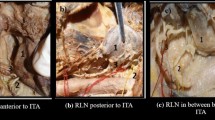Abstract
Purpose
To evaluate the course of lower cranial nerves (CNs) within the neck in relation to surrounding structures and anatomic landmarks via a cadaveric dissection study.
Methods
A total of 70 neck dissections (31 bilateral, 8 unilateral) were performed on 39 adult fresh cadavers [mean (SD) age: 38.5 (11.2) years, 29 male, 10 female] to identify the course of lower CNs [spinal accessory nerve (SAN), vagus nerve and hypoglossal nerve] within the neck in relation to surrounding structures [internal jugular vein (IJV), common carotid artery (CCA)] and distance to anatomical landmarks (cricoid cartilage, hyoid bone, digastric muscle).
Results
SAN travelled most commonly anterior to IJV (51.4%) at the level of jugular foramen, while travelling lateral to IJV at the post belly of digastric (55.7%) and inferior to digastric muscle (90%) in most neck dissections. Vagus nerve travelled lateral to CCA in majority (94.3%) of dissections, while medial (2.9%), posterolateral (1.4%) and posterior (1.4%) positions were also noted. Average distance of hypoglossal nerve was 27.7 (9.7) mm to carotid bifurcation, 9.3 (3.9) mm to hyoid bone, and 54.7 (18.0) mm to the inferior border of cricoid cartilage.
Conclusion
In conclusion, our findings indicate that anatomic variations are not rare in the course of lower CNs within the neck in relation to adjacent structures, and awareness of these variations together with knowledge of distance to certain anatomic landmarks may help the surgeon to identify lower CNs during neck surgery and prevent potential nerve injuries.



Similar content being viewed by others
References
Boström D, Dahlin LB (2007) Iatrogenic injury to the accessory nerve. Scand J Plast Reconstr Surg Hand Surg 41:82–87
Skinner SA (2011) Neurophysiologic monitoring of the spinal accessory nerve, hypoglossal nerve, and the spinomedullary region. J Clin Neurophysiol 28:587–598
Popovski V, Benedetti A, Popovic-Monevska D, Pacnevski G, Iliev A, Stamatoski A, Zhivadinovik J (2015) Еffectiveness of spinal accessory nerve preservation in modified neck dissections. RJPBCS 6:1184–1191
Aramrattana A, Sittitrai P, Harnsiriwattanagit K (2005) Surgical anatomy of the spinal accessory nerve in the posterior triangle of the neck. Asian J Surg 28:171–173
Brandenburg JH, Lee CYS (1981) The eleventh nerve in radical neck surgery. Laryngoscope 91:1851–1859
Nason RW, Abdulrauf BM, Stranc MF (2000) The anatomy of the accessory nerve and cervical lymph node biopsy. Am J Surg 180:241–243
Watkins JP, Williams GB, Mascioli AA, Wan JY, Samant S (2011) Shoulder function in patients undergoing selective neck dissection with or without radiation and chemotherapy. Head Neck 33:615–619
Hinsley ML, Hartig GK (2010) Anatomic relationship between the spinal accessory nerve and internal jugular vein in the upper neck. Otolaryngol Head Neck Surg 143:239–241
Cunningham EJ, Bond R, Mayberg MR, Warlow CP, Rothwell PM (2004) Risk of persistent cranial nerve injury after carotid endarterectomy. J Neurosurg 101:445–448
Meng S, Reissig LF, Tzou CH, Meng K, Grisold W, Weninger W (2016) Ultrasound of the hypoglossal nerve in the neck: visualization and initial clinical experience with patients. AJNR Am J Neuroradiol 37:354–359
Mahadevappa K, Chacko T, Nair AK (2012) Isolated unilateral hypoglossal nerve palsy due to vertebral artery dissection. Clin Med Res 10:127–130
Junquera L, Gallego L (2012) Images in clinical medicine: denervation atrophy of the tongue after hypoglossal-nerve injury. N Engl J Med 367:156
Keane JR (1996) Twelfth-nerve palsy: analysis of 100 cases. Arch Neurol 53:561–566
Saki N, Nikakhlagh S (2012) Complications of neck dissection. In: Kummoona R (ed) Neck dissection—clinical application and recent advances. InTech, ISBN: 978-953-51-0104-8. http://www.intechopen.com/books/neck-dissection-clinical-application-and-recent-advances/complicationof-neck-dissection. https://doi.org/10.5772/32638
Lo A, Oehley M, Bartlett A, Adams D, Blyth P, Al-Ali S (2006) Anatomical variations of the common carotid artery bifurcation. ANZ J Surg 76:970–972
Chaukar DA, Pai A, D’Cruz AK (2006) A technique to identify and preserve the spinal accessory nerve during neck dissection. J Laryngol Otol 120:494–496
Saman M, Etebari P, Pakdaman MN, Urken ML (2011) Anatomic relationship between the spinal accessory nerve and the jugular vein: a cadaveric study. Surg Radiol Anat 33:175–179
Lucev N, Bobinac D, Maric I, Drescik I (2000) Variations of the great arteries in the carotid triangle. Otolaryngol Head Neck Surg 122:590–591
Overland J, Hodge JC, Breik O, Krishnan S (2016) Surgical anatomy of the spinal accessory nerve: review of the literature and case report of a rare anatomical variant. J Laryngol Otol 130:969–972
Taylor CB, Boone JL, Schmalbach CE, Miller FR (2013) Intraoperative relationship of the spinal accessory nerve to the internal jugular vein: variation from cadaver studies. Am J Otolaryngol 34:527–529
Kierner AC, Zelenka I, Heller S, Burian M (2000) Surgical anatomy of the spinal accessory nerve and the trapezius branches of the cervical plexus. Arch Surg 135:1428–1431
Lee SH, Lee JK, Jin SM, Kim JH, Park IS, Chu HR, Ahn HY, Rho YS (2009) Anatomic variations of the spinal accessory nerve and its relevance to level IIb lymph nodes. Otolaryngol Head Neck Surg 141:639–644
Cappiello J, Piazza C, Nicolai P (2007) The spinal accessory nerve in head and neck surgery. Curr Opin Otolaryngol Head Neck Surg 15:107–111
Assadian A, Senekowitsch C, Pfaffelmeyer N, Assadian O, Ptakovsky H, Hagmuller GW (2004) Incidence of cranial nerve injuries after carotid eversion endarterectomy with a transverse skin incision under regional anaesthesia. Eur J Vasc Endovasc Surg 28:421–424
Funding
None.
Author information
Authors and Affiliations
Corresponding author
Ethics declarations
Conflict of interest
Authors declare that they have no conflict of interest.
Ethical approval
All procedures performed were in accordance with the ethical standards of the institutional and/or national research committee and with the 1964 Helsinki declaration and its later amendments or comparable ethical standards. This study was approved by the institutional ethics committee of Istanbul Forensic Medicine Institution (date of approval: 17/02/2015, Reference number/Protocol No: 21589509/18355/18).
Informed consent
N/A (a cadaveric dissection study).
Rights and permissions
About this article
Cite this article
Yigit, E., Dursun, E., Omeroglu, E. et al. The course of lower cranial nerves within the neck: a cadaveric dissection study. Eur Arch Otorhinolaryngol 275, 2541–2548 (2018). https://doi.org/10.1007/s00405-018-5091-4
Received:
Accepted:
Published:
Issue Date:
DOI: https://doi.org/10.1007/s00405-018-5091-4




